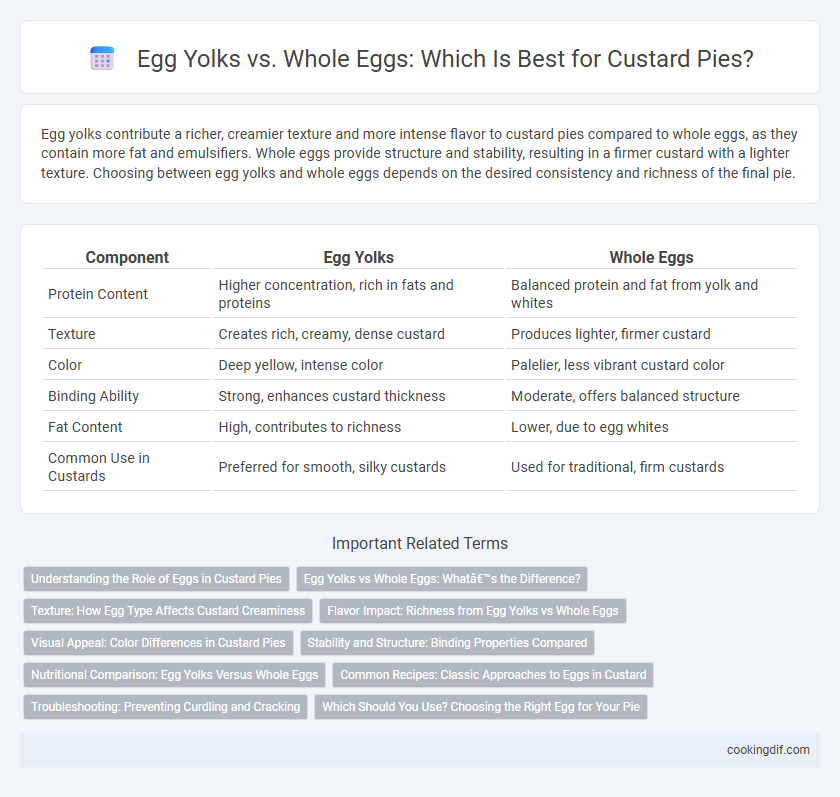Egg yolks contribute a richer, creamier texture and more intense flavor to custard pies compared to whole eggs, as they contain more fat and emulsifiers. Whole eggs provide structure and stability, resulting in a firmer custard with a lighter texture. Choosing between egg yolks and whole eggs depends on the desired consistency and richness of the final pie.
Table of Comparison
| Component | Egg Yolks | Whole Eggs |
|---|---|---|
| Protein Content | Higher concentration, rich in fats and proteins | Balanced protein and fat from yolk and whites |
| Texture | Creates rich, creamy, dense custard | Produces lighter, firmer custard |
| Color | Deep yellow, intense color | Palelier, less vibrant custard color |
| Binding Ability | Strong, enhances custard thickness | Moderate, offers balanced structure |
| Fat Content | High, contributes to richness | Lower, due to egg whites |
| Common Use in Custards | Preferred for smooth, silky custards | Used for traditional, firm custards |
Understanding the Role of Eggs in Custard Pies
Egg yolks contribute richness and creaminess to custard pies by providing fats and emulsifiers that create a smooth texture. Whole eggs add structure and stability through their protein content, which helps the custard set firmly without becoming rubbery. Balancing egg yolks and whole eggs allows for optimal consistency, ensuring a custard pie with both silky mouthfeel and cohesive firmness.
Egg Yolks vs Whole Eggs: What’s the Difference?
Egg yolks provide a richer, creamier texture and a deeper yellow color to custard pies due to their higher fat content, enhancing flavor and smoothness. Whole eggs contribute both whites and yolks, resulting in a lighter, firmer custard with increased structure and less richness. Selecting egg yolks versus whole eggs influences the pie's consistency, with yolks offering velvety custards and whole eggs yielding a more set, sliceable filling.
Texture: How Egg Type Affects Custard Creaminess
Egg yolks contribute a rich, velvety texture to custard pies by providing higher fat content, enhancing creaminess and smoothness. Whole eggs offer a firmer structure due to their albumen proteins, resulting in a custard with a more set and slightly denser texture. Balancing yolks and whole eggs is essential for achieving the desired custard consistency, as yolks yield silkiness while whole eggs promote stability.
Flavor Impact: Richness from Egg Yolks vs Whole Eggs
Egg yolks contribute a deep, creamy richness and a velvety texture to custard pies, intensifying the flavor with their high fat content and natural emulsifiers. Whole eggs provide a balanced structure with a lighter texture, offering both richness from the yolks and stability from the whites. Using more yolks enhances the custard's lusciousness and golden color, while whole eggs deliver a firmer setting and subtle flavor complexity.
Visual Appeal: Color Differences in Custard Pies
Egg yolks contribute a rich, golden-yellow hue to custard pies, enhancing their visual appeal and signaling creamy texture. Whole eggs produce a paler custard with a more muted color, which may appear less vibrant but lighter in tone. The higher pigment concentration in yolks intensifies the custard's color, making pies more visually inviting and appetizing.
Stability and Structure: Binding Properties Compared
Egg yolks provide superior binding properties in custard pies due to their higher fat and protein content, which enhances stability and creates a rich, creamy texture. Whole eggs contribute more liquid and albumin, resulting in a firmer structure but can make the custard less smooth if overused. Using primarily egg yolks ensures optimal custard firmness without compromising silkiness, balancing both stability and structure effectively.
Nutritional Comparison: Egg Yolks Versus Whole Eggs
Egg yolks provide a richer source of vitamins A, D, E, and K, as well as higher concentrations of fat and cholesterol, which contribute to the creamy texture in custard pies. Whole eggs offer a balanced profile of protein and essential nutrients, including both the yolk's fat-soluble vitamins and the whites' high-quality protein, resulting in a firmer custard structure. Choosing between egg yolks and whole eggs affects the custard's nutritional density, caloric content, and texture, with yolks increasing richness and whole eggs enhancing protein content.
Common Recipes: Classic Approaches to Eggs in Custard
Custard pies commonly use whole eggs to achieve a balanced texture that combines firmness with creaminess, while egg yolks alone produce a richer, denser custard with a more velvety mouthfeel. Classic recipes often call for a ratio of whole eggs and additional yolks to enhance smoothness and improve stability during baking. The choice between whole eggs and yolks affects the custard's color, flavor intensity, and set, crucial for achieving the signature consistency of traditional custard pies.
Troubleshooting: Preventing Curdling and Cracking
Egg yolks provide a rich, smooth texture in custard pies while minimizing the risk of curdling and cracking, thanks to their fat and emulsifying properties. Whole eggs increase firmness and structure but require careful temperature control during baking to prevent overcooking and curdling. Maintaining a low oven temperature, using a water bath, and avoiding rapid temperature changes ensures even cooking and prevents texture issues in custard pies.
Which Should You Use? Choosing the Right Egg for Your Pie
Egg yolks create a richer, creamier custard pie with a dense, silky texture due to their high fat content, making them ideal for a luxurious filling. Whole eggs provide structure and stability, contributing to a firmer, more set custard, which holds its shape better when sliced. For a balanced custard pie, combining whole eggs with extra yolks enhances both creaminess and firmness, achieving a smooth and stable result.
Egg yolks vs Whole eggs for custard pies Infographic

 cookingdif.com
cookingdif.com